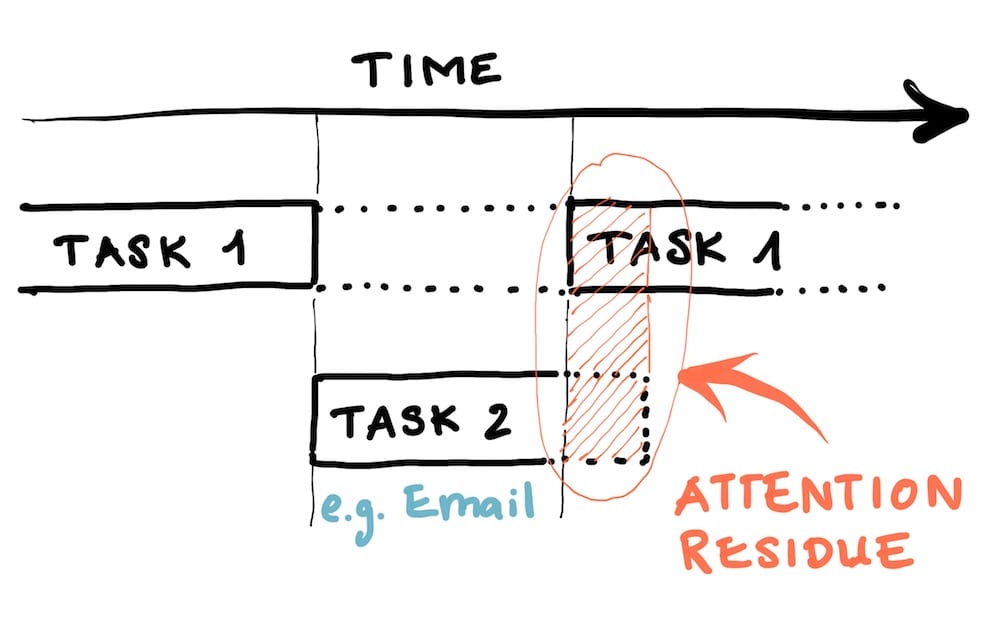Why MULTITASKING destroys PRODUCTIVITY
Dealing with distractions is one of the greatest challenges we face in our growing knowledge economy and Multitasking increasingly becomes a synonym…

Dealing with distractions is one of the greatest challenges we face in our growing knowledge economy and Multitasking increasingly becomes a synonym for being outstandingly productive.
Unfortunately, research shows that the opposite is true and Multitasking actually compromises our ability to be productive.
In this article I want to debunk the myth of Multitasking and give you a better understanding how it evolved and why Email, Slack and Co are not our best friends when it comes to producing value in today’s economy.The knowledge economy has NO metric to measure individuals value output.

A brief look at history
Let’s quickly go back in time too see how our work evolved over the last centuries.
In the pre-industrial society most of the people were living in the country side earning a living with agriculture and animal farming. For the most part, people owned a piece of land and sold the goods they produced. Everyone, to put it in today’s terms, was an entrepreneur.
Around the 18th century people slowly but steadily began to move from the country side to find work in the bigger metropolises.
With the invention of steam engines, muscle force and sweat is slowly replaced by machinery. Productivity increased exponentially.
The industrial age, especially with the contribution of Henry Ford, was all about optimizing processes and mass production: reducing costs and paying high wages for workers. This led to the rise of mega companies. Working in a factory is hot, requires less physical effort and pays better. Yeah!
Transitioning into the information age
With the development of the personal computer and the internet, people slowly moved away from the production line into cubicles and behind a desk.
While in the industrial age the output was measured by the number of products created in x amount of time, we now face a new challenge in the knowledge economy.
Compared to the industrial age we have no real metrics to measure our output. We are not walking into a factory every morning and count the numbers of products at the end of the day.
Our factory today looks different. We are going into the office and turn on the computer. On the one hand, a brilliant machine that makes our lives much easier and offers unlimited possibilities, but on the other hand it is also a black box that creates products in an intangible format.

The emergence of PLACEBO metrics
For people, who are working in a bigger corporation, it is hard to measure their contribution to the overall success of a company. This results in a natural conflict between employee and employer. Because the company cannot directly see their contribution, people need to come up with ways to proof that they’re worth their paycheck.
To illustrate that this is a contemporary problem, I want to take this example of Yahoo:
In 2012, when Marissa Mayer became CEO of Yahoo, she became infamous for banning home office from the company. People were required to get their work done at the office. Mayer argued, that serendipitous moments (that supposedly create value for the company) can only appear when people bump into each other. Furthermore she believed that effective collaboration can only happen when people meet face to face.
While there is certainly some truth to it, we cannot dismiss the fact that Mayer had a look at the server log files where she discovered that most people haven’t logged in for days. She had reason to believe, that people abused the home office policies and had too much ‘comfort’.
The point being is, that server logins suddenly become a false metric for productivity. This example shall demonstrate the emerging trend of using non related metrics to justify productivity.

The difference between being busy and being productive
Drawing back the circle to Multitasking.
As already shown with the example above, shallow activities, such as a login, suddenly become a measurement of productivity.
Especially networking tools such as Email or Instant Messengers, are great examples for shallow activities. Because they create this indirect pressure to be omnipresent all the time, knowledge workers are indirectly forced to be responsive immediately in order to create the perception of being productive.
In addition to that, other types of shallow tasks are emerging to dominate the daily agenda and workers who seem to handle multiple things at once, are good workers.
Today, engaging in email conversations while sitting in a meeting is normal. Sharing interesting articles with the entire company to show that one does his research is expected. Or just simply the fact of putting someone in CC makes one look busy as well.
However, when it boils down to creating value, all of these tasks do not contribute to the big picture but are a distraction that prevents people from dealing with the important tasks.
Having multiple tasks on ones plate, is also fundamental conflict in itself.

Why people are not really multitasking
While many people assume that they can multitask and handle all kind of things at the same time, reality actually shows the contrary.
Some might think: “Of course, I can write an email and talk to a colleague at the same time.”
Sorry, but that’s a myth. What actually happens, that not many realize, is that their attention is switching between tasks back and forth in split seconds. It happens so fast that it creates the illusion of Multitasking. If you pay attention next time, you will notice.
It is true that we can do multiple tasks at the same time.
However, we can only focus on one task at a time.

Why Multitasking creates errors and reduces productivity due to Attention Residue
Above I already explained that Multitasking is not a real thing because we just switch our focus back and forth between tasks.
Shifting the focus back and forth creates another phenomenon which is called attention residue.
Research shows that whenever we switch from on task to another, our attention is still with the previous task for the next 20 – 30min. I am sure you can easily recall situations where you get an email on a Sunday morning and cannot stop thinking about it for the rest of the day.
This leads to a lack of attention for the new tasks and to reduced productivity because we are not using 100% of our brainpower for new tasks.
With that in mind, we can imagine what happens if we try to handle more than two tasks at the same time: the attention split creates errors and reduces productivity for the current task dramatically.
Here is a quick sketch what I mean:


What can you do?
Knowing the challenges of the knowledge economy, that Multitasking is not working and that handling multiple tasks at the same time is disrupting our productivity, leaves us wondering what we can do.
Well, I am glad you asked. Here are a couple of things you can try to implement in your daily routine:
- schedule blocks for undistracted work (usually 60-90 min because it takes at least 30 min to get into focus)
- if you are working in a team, communicate and agree on blocks for undistracted work so people know
- turn off the internet (if you need it for research purpose, plan ahead and split between off and online tasks)
- turn off all messenger apps (email, slack, whatsapp, fb messenger)
- put your smartphone into flight mode so you won’t get distracted by incoming notifications or calls
- noise cancelling headphones can help in noisy environments
If you are further interested in the science behind that, I can highly recommend the book “Deep Work” which also inspired me to write this article. It will give you much more insights, great examples that backs up the theory and neurological explanation of how focus works.
